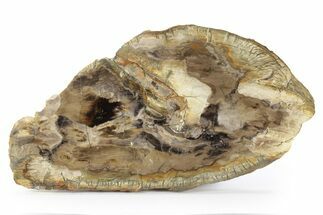This Specimen has been sold.
8" Polished, Jasper Replaced Petrified Wood Slab - Oregon
This is a beautiful slab of agate/jasper replaced petrified wood from Hampton Butte, Oregon. The jasper replacement leaves a beautiful coloration with hues of greens and whites but unfortunately destroys the detail that would allow for the type of tree to be identified. It has been polished to a glossy finish on one side and comes with an acrylic display stand.
Hampton Butte petrified wood comes in a variety of colors, but it is specifically the turquoise and dark green variants that draw collectors to specimens from this area. This wood is explicitly collected from Hampton Butte, a geologic formation located in Deschutes County of central Oregon.
Hampton Butte wood is distinguished by outer portions colored a rich brown and white mix with interior cores of multi-colored agate, jasper or common opal. The highly prized green colors are thought to be a result of localized oxidation and reduction of iron content while the wood fossilized. Other portions of the wood, specifically those that are filled by chalcedony, sport red, gold, and blue colors alongside the green coloring.
Hampton Butte wood is distinguished by outer portions colored a rich brown and white mix with interior cores of multi-colored agate, jasper or common opal. The highly prized green colors are thought to be a result of localized oxidation and reduction of iron content while the wood fossilized. Other portions of the wood, specifically those that are filled by chalcedony, sport red, gold, and blue colors alongside the green coloring.
About Agate
Agate is a variety of microcrystalline quartz (chalcedony) that displays translucence and, in some cases, banding. Agate primarily forms when silica-rich fluids fill pockets within rocks and/or fossils, depositing the silica along the walls of the rock. This process can result in banding patterns, as the compositions and impurities of these depositing fluids change over time. These banding patterns can either form as flat layers, creating linear patterns known as waterline agate, or as rounded layers, forming more common ring-like patterns. These patterns depend on the surfaces available for deposition.
Agate is a variety of microcrystalline quartz (chalcedony) that displays translucence and, in some cases, banding. Agate primarily forms when silica-rich fluids fill pockets within rocks and/or fossils, depositing the silica along the walls of the rock. This process can result in banding patterns, as the compositions and impurities of these depositing fluids change over time. These banding patterns can either form as flat layers, creating linear patterns known as waterline agate, or as rounded layers, forming more common ring-like patterns. These patterns depend on the surfaces available for deposition.
About Jasper
Jasper is a term that can be applied to an opaque variety of chalcedony. The opaqueness is due to a higher concentration of impurities mixed with silica/quartz compared to other varieties of silica, such as quartz or agates. Like agate it may form in a wide variety of colors, and is often multi-colored. In most cases, jasper forms when silica-rich fluids permeate throughout a soft sediment or volcanic debris deposit. The fluids then crystallize around the particles/impurities, resulting in a cementation process. Most often, the impurities present determine the coloration of the deposit following solidification, but other factors can play a role in the color of what is now considered a jasper.
Jasper is a term that can be applied to an opaque variety of chalcedony. The opaqueness is due to a higher concentration of impurities mixed with silica/quartz compared to other varieties of silica, such as quartz or agates. Like agate it may form in a wide variety of colors, and is often multi-colored. In most cases, jasper forms when silica-rich fluids permeate throughout a soft sediment or volcanic debris deposit. The fluids then crystallize around the particles/impurities, resulting in a cementation process. Most often, the impurities present determine the coloration of the deposit following solidification, but other factors can play a role in the color of what is now considered a jasper.
SPECIES
Chalcedony var. Jasper/Agate
LOCATION
Hampton Butte, Oregon
SIZE
8 x 7", .55" thick
CATEGORY
SUB CATEGORY
ITEM
#214970
We guarantee the authenticity of all of our specimens.
 Reviews
Reviews











